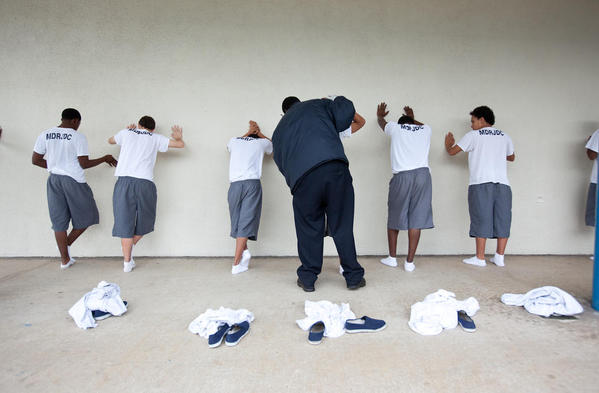Staff member patting down inmates at Miami-Dade Regional Juvenile Detention Center - Photo by Richard Ross
____________
“Disturbingly high rates of ACEs” were found in 64,329 juvenile offenders in Florida — 27% of males and 45% of females reported 5 or more ACEs, more than 80 percent of all had experienced family violence. ACEs Connection members Nathan Epps, Nancy Hardt, and Michael Baglivio are among the six co-authors of this groundbreaking study published in the Journal of Juvenile Justice.
Abstract: The study of adverse childhood experiences (ACEs) and their negative repercussion on adult health outcomes is well documented. In a population of insured Californians, a dose-response relationship has been demonstrated among 10 ACEs and a host of chronic physical health, mental health, and behavioral outcomes. Less widely studied is the prevalence of these ACEs in the lives of juvenile offenders, and the effect of ACEs on children. This study examines the prevalence of ACEs in a population of 64,329 juvenile offenders in Florida. This article reports the prevalence of each ACE and assigns an ACE composite score across genders and a risk to reoffend level classification, and compares these with ACE studies conducted on adults. Analyses indicate offenders report disturbingly high rates of ACEs and have higher composite scores than previously examined populations. Policy implications underline the need to screen for and address ACEs as early as possible to prevent reoffending and other well-documented sequelae.
Conclusion: The current study presents findings from a large sample of more than 64,000 Florida youth who happen to be juvenile offenders. Our future research will examine how ACEs contribute to more immediate behavioral outcomes across multidisciplinary domains of school, peer associations, family, substance abuse, and employment, as well as criminal behaviors, all available within the data we have amassed. Furthermore, future research should address the relative contributions of each distinct ACE on myriad outcomes. Past and ongoing ACEs are the thread that unifies this unique population, and how we address the impact of those experiences should be the target of policy analysis and development to the greatest extent possible. Perhaps doing so is the key to “what works” after all.
Full article: http://www.journalofjuvjustice.org/JOJJ0302/article01.htm




Comments (0)